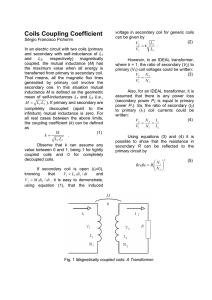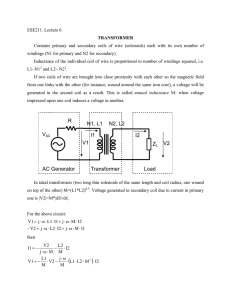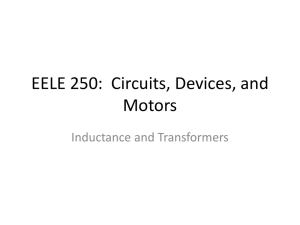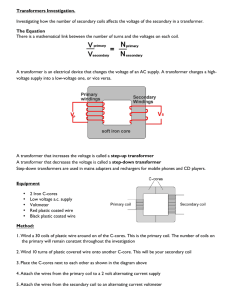Lecture 23 Mutual Induction and Transformers Nov. 28, 2011
advertisement
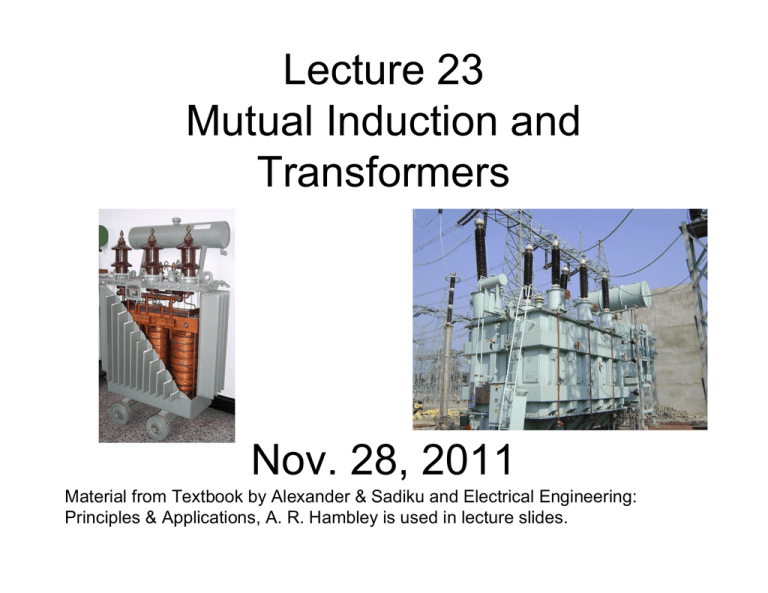
Lecture 23 Mutual Induction and Transformers Nov. 28, 2011 Material from Textbook by Alexander & Sadiku and Electrical Engineering: Principles & Applications, A. R. Hambley is used in lecture slides. Magnetically Coupled Circuit Chapter 13 in A & S • • • • • • Mutual Inductance Energy in a Coupled Circuit What is a transformer? Linear Transformers Ideal Transformers Applications 2 Inductance and Mutual Inductance Definition of inductance L: Flux linkages ! L= = current i Substitute for the flux linkages using N! L= i 3 " = N! Inductance and Mutual Inductance Substituting 2 N L= R Ni != R Faraday’s Law $ r r d E " dl = # dt r r $$ B" dS Voltage is induced in a coil when its flux ! linkages change: 4 d! d ( Li ) di e= = =L dt dt dt Mutual Inductance Self inductance for coil 1 Self inductance for coil 2 !11 L1 = i1 !22 L2 = i2 Mutual inductance between coils 1 and 2: 5 !21 !12 M = = i1 i2 Mutual Inductance Total fluxes linking the coils: !1 = !11 ± !12 !2 = !22 ± !21 6 Mutual Inductance Currents entering the dotted terminals produce aiding fluxes 7 Check the right hand rule! Mutual Inductance: Dot Convention • If a current enters the dotted terminal of one coil, the reference polarity of the mutual voltage in the second coil is positive at the dotted terminal of the second coil. Check the right hand rule again! 8 Mutual Inductance • It is the ability of one inductor to induce a voltage across a neighboring inductor, measured in henrys (H). di1 v2 = M 21 dt The open-circuit mutual voltage across coil 2 v1 = M 12 di2 dt The open-circuit mutual voltage across9 coil 1 Mutual Inductance Dot convention for coils in series; the sign indicates the polarity of the mutual voltage; (a) series-aiding connection, (b) series-opposing connection. L = L1 + L2 + 2 M L = L1 + L2 " 2M (series - opposing connection) (series - aiding connection) 10 ! 1 2 11 Circuit Equations for Mutual Inductance !1 = L1i1 ± Mi2 !2 = ± Mi1 + L2i2 d!1 di1 di2 e1 = = L1 ±M dt dt dt d! 2 di1 di2 e2 = = ±M + L2 dt dt dt Example N1i1 100i1 !5 "1 = = = 10 i1 7 R 10 #21 = N 2$1 = 200 ! 10 "5 i1 #21 Mutual inductance: M = = 2mH i1 12 Example Does the flux produced by i2 aid or oppose the flux produced by i1? 13 di1 di2 e1 = L1 !M dt dt di2 di1 e2 = L2 !M dt dt Right Hand Rule! Mutual Inductance Time-domain analysis of a circuit containing coupled coils. Frequency-domain analysis of a circuit containing coupled coils 14 Mutual Inductance Example Calculate the phasor voltage Vo Ans: Vo = 10" #135° V 15 Magnetic Materials 16 Magnetic Materials Residual alignment at H=0 Total alignment Alignment 2-3 Linear 12 • Magnetic field of atoms within small domains are aligned • Magnetic fields of the small domains are initially randomly oriented • As the magnetic field intensity increases, the domains tend to align, leaving a residual alignment even when the applied field is reduced to zero 17 Magnetic Materials The relationship between B and H is not linear for the types of iron used in motors and transformers. B-H curves exhibits “hysterysis” 18 Energy Considerations t t " ! ! ! d" W = vi dt = N i dt = Ni d" dt 0 0 0 Ni = Hl and d" = AdB B B W = AlH dB = Vcore H dB ! ! 0 0 B 19 W = WV = H dB V ! 0 Energy Considerations B W Wv = = ! H dB Al 0 The area between the B-H curve and the B axis represents the volumetric energy supplied to the core 20 21 Core Loss Power loss due to hysteresis is proportional to frequency, assuming constant peak flux. 400 Hz vs 60 Hz transformers 22 23 Energy Stored in the Magnetic Field B Wv = ! 0 24 2 B B dB = µ 2µ Energy in a Coupled Circuit • The coupling coefficient, k, is a measure of the magnetic coupling between two coils; 0≤k≤1. M = k L1 L2 • The instantaneous energy stored in the circuit is given by 1 2 1 2 w = L1i1 + L2i2 ± MI1 I 2 2 2 25 What is a transformer? • It is an electrical device designed on the basis of the concept of magnetic coupling • It uses magnetically coupled coils to transfer energy from one circuit to another • It is the key circuit elements for stepping up or stepping down ac voltages or currents, impedance matching, isolation, etc. 26 Linear Transformer • It is generally a four-terminal device comprising two (or more) magnetically coupled coils V " 2M 2 Z in = = R1 + j"L1 + Z R , Z R = is reflected impedance I1 R2 + j"L2 + Z L 28 ! Linear Transformer Example In the circuit below, calculate the input impedance and current I1. Take Z1=60-j100Ω, Z2=30+j40Ω, & ZL=80+j60Ω. r r Z in = Z1 + j20 + Ans: (M 2 = 5 2 ) r r ( j40 + Z 2 + Z L ) Zin = 100.14! # 53.1°"; I1 = 0.5!113.1°A ! *Worked out as Example 13.4 in textbook 29 Ideal Transformer • An ideal transformer is a unity-coupled, lossless transformer in which the primary and secondary coils have infinite self-inductances. V2 N 2 = =n V1 N1 (a) (b) Ideal Transformer Circuit symbol I 2 N1 1 = = I1 N 2 n V2>V1→ step-up transformer V2<V1→ step-down transformer 30 Ideal Transformer Example An ideal transformer is rated at 2400/120V, 9.6 kVA, and has 50 turns on the secondary side. Calculate: (a) the turns ratio, (b) the number of turns on the primary side, and (c) the current ratings for the primary and secondary windings. Ans: (a) This is a step-down transformer, n=0.05 (b) N1 = 1000 turns (c) I1 = 4A and I2 = 80A -- Maximum 31 Applications • Transformer as an Isolation Device to isolate ac supply from a rectifier 32 Applications • Transformer as an Isolation Device to isolate dc between two amplifier stages. 33 Applications • Transformer as a Matching Device Using an ideal transformer to match the speaker to the amplifier Equivalent circuit 34 Applications Example Calculate the turns ratio of an ideal transformer required to match a 100Ω load to a source with internal impedance of 2.5kΩ. Find the load voltage when the source voltage is 30V. Ans: n = 0.2; VL = 3V 35 Applications • A typical power distribution system 36
